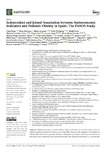Mostrar o rexistro simple do ítem
Independent and joined association between socioeconomic indicators and pediatric obesity in Spain: the PASOS Study
| dc.contributor.author | González Valeiro, Miguel | |
| dc.contributor.author | Homs, Clara | |
| dc.contributor.author | Gómez, Santiago Felipe | |
| dc.contributor.author | Schröder, Helmut | |
| dc.date.accessioned | 2024-02-06T11:46:16Z | |
| dc.date.available | 2024-02-06T11:46:16Z | |
| dc.date.issued | 2023-04-20 | |
| dc.identifier.citation | Homs, C.; Berruezo, P.; Arcarons, A.; Wärnberg, J.; Osés, M.; González-Gross, M.; Gusi, N.; Aznar, S.; Marín-Cascales, E.; González-Valeiro, M.Á.; et al. Independent and Joined Association between Socioeconomic Indicators and Pediatric Obesity in Spain: The PASOS Study. Nutrients 2023, 15, 1987. https://doi.org/10.3390/ nu15081987 | es_ES |
| dc.identifier.issn | 2072-6643 | |
| dc.identifier.uri | http://hdl.handle.net/2183/35435 | |
| dc.description.abstract | [Abstract]: Introduction: Childhood obesity is a public health problem worldwide. An important determinant of child and adolescent obesity is socioeconomic status (SES). However, the magnitude of the impact of different SES indicators on pediatric obesity on the Spanish population scale is unclear. The aim of this study was to assess the association between three SES indicators and obesity in a nationwide, representative sample of Spanish children and adolescents. A total of 2791 boys and girls aged 8 to 16 years old were included. Their weight, height, and waist circumference were measured. SES was assessed using two parent/legal guardian self-reported indicators (educational level -University/non- University- and labor market status -Employed/Unemployed-). As a third SES indicator, the annual mean income per person was obtained from the census section where the participating schools were located (_12.731 /<12.731 ). The prevalence of obesity, severe obesity, and abdominal obesity was 11.5%, 1.4%, and 22.3%, respectively. Logistic regression models showed an inverse association of both education and labor market status with obesity, severe obesity, and abdominal obesity (all p < 0.001). Income was also inversely associated with obesity (p < 0.01) and abdominal obesity (p < 0.001). Finally, the highest composite SES category (University/Employed/_12.731 n = 517) showed a robust and inverse association with obesity (OR = 0.28; 95% CI: 0.16–0.48), severe obesity (OR = 0.20; 95% CI: 0.05–0.81), and abdominal obesity (OR = 0.36; 95% CI: 0.23–0.54) in comparison with the lowest composite SES category (Less than University/Unemployed/<12.731 ; n = 164). No significant interaction between composite SES categories and age and gender was found. SES is strongly associated with pediatric obesity in Spain. | es_ES |
| dc.description.sponsorship | The PASOS study was funded by Fundación PROBITAS (2019) and the Gasol Foundation (2019-2020). Additional funds were received from the Barça Foundation (2019-2020), Banco Santander (2019), IFA (2019-2020), Vienna (2019), and the Fundación Deporte Joven (2019) (no references are applicable). J.A.T., M.G.-G. and C.B. are funding by Instituto de Salud Carlos III through the CIBEROBN CB12/03/30038, which are co-funded by the European Regional Development Fund. | es_ES |
| dc.language.iso | eng | es_ES |
| dc.publisher | MDPI | es_ES |
| dc.relation.uri | https://doi.org/10.3390/nu15081987 | es_ES |
| dc.rights | Atribución 3.0 España | es_ES |
| dc.rights.uri | http://creativecommons.org/licenses/by/3.0/es/ | * |
| dc.subject | Obesity | es_ES |
| dc.subject | Child | es_ES |
| dc.subject | Adolescent | es_ES |
| dc.subject | Socioeconomic status | es_ES |
| dc.subject | Cross-sectional study | es_ES |
| dc.title | Independent and joined association between socioeconomic indicators and pediatric obesity in Spain: the PASOS Study | es_ES |
| dc.type | info:eu-repo/semantics/article | es_ES |
| dc.rights.access | info:eu-repo/semantics/openAccess | es_ES |
| UDC.journalTitle | Nutrients | es_ES |
| UDC.volume | 15 | es_ES |
| UDC.issue | 8 | es_ES |
Ficheiros no ítem
Este ítem aparece na(s) seguinte(s) colección(s)
-
GI-ESAFEX - Artigos [47]






